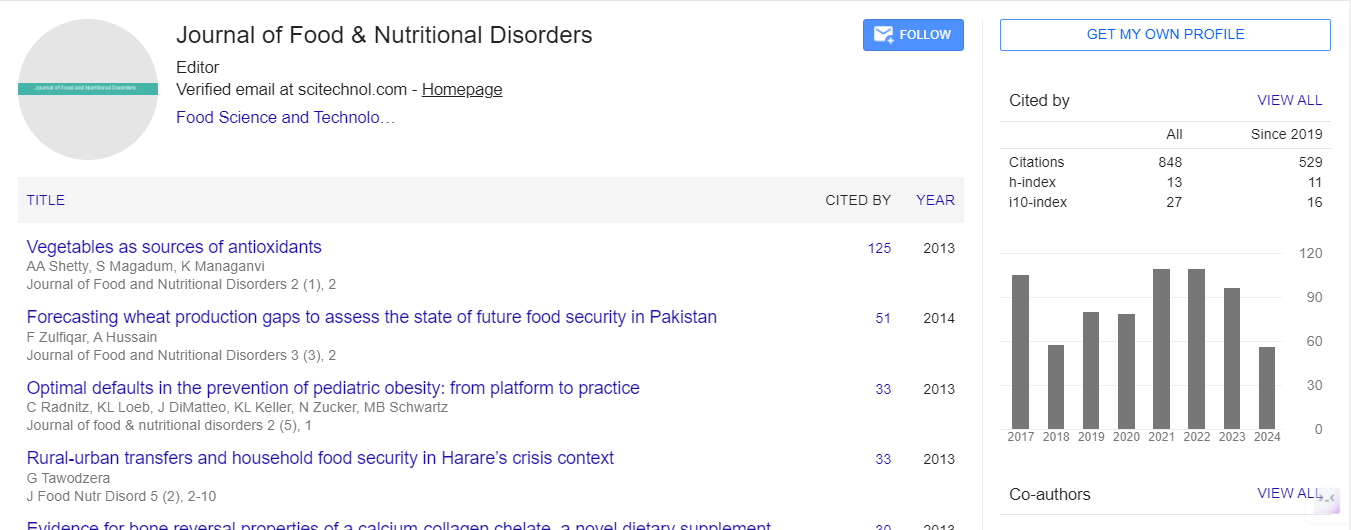Opinion Article, J Food Nutr Disor Vol: 13 Issue: 5
Investigating the Contemporary Usage of Nixtamalization in Nutrient Enhancement
Clara Evans*
1Department of Nutrition, Johns Hopkins University, Baltimore, Maryland, USA
*Corresponding Author: Clara Evans,
Department of Nutrition, Johns Hopkins
University, Baltimore, Maryland, USA
E-mail: liumaya2@oulook.com
Received date: 24 September, 2024, Manuscript No. JFND-24-151332;
Editor assigned date: 26 September, 2024, PreQC No. JFND-24-151332 (PQ);
Reviewed date: 11 October, 2024, QC No. JFND-24-151332;
Revised date: 21 October, 2024, Manuscript No JFND-24-151332 (R);
Published date: 28 October, 2024, DOI: 10.4172/2324-9323.1000432
Citation: Evans C (2024) Investigating the Contemporary Usage of Nixtamalization in Nutrient Enhancement. J Food Nutr Disor 13:5.
Description
The contemporary usage of nixtamalization as a method for nutrient enhancement represents a compelling area of investigation, with intense implications for food sustainability, nutritional enrichment, and cultural heritage. Nixtamalization, an ancient Mesoamerican food processing technique, involves treating maize with an alkaline solution, such as lime water, which leads to the production of nixtamal. This process has been shown to enhance the nutritional quality, flavor, and functional properties of maize-based foods, making it a topic of significant interest for researchers, food technologists, and nutritionists. A key focus of investigating the contemporary usage of nixtamalization in nutrient enhancement is the preservation of traditional culinary practices and the promotion of culturally diverse and sustainable food systems. Nixtamalization has been integral to the culinary heritage of Latin American and Mesoamerican cultures for centuries. By resarch its modern applications, researchers and food enthusiasts are not only contributing to the preservation of traditional food practices but also encourage a deeper appreciation for cultural diversity in food consumption. Additionally, the sustainable nature of nixtamalization, which facilitates enhanced digestibility, reduced mycotoxins, and improved nutrient bioavailability, aligns with the global shift towards sustainable and locally sourced food options.
Furthermore, investigating the contemporary usage of nixtamalization provides insights into the potential for nutrient enhancement and fortification in staple foods, thereby addressing public health concerns related to malnutrition and dietary deficiencies. Nixtamalization has been demonstrated to effectively reduce levels of antinutrients such as phytic acid, increase the content of essential amino acids, and improve mineral bioavailability, all of which contribute to enhanced nutrient density in maize-based foods. By exploring the contemporary applications of nixtamalization, researchers can elucidate its role in combating malnutrition and supporting public health initiatives by fortifying staple foods with essential nutrients.
Moreover, the contemporary usage of nixtamalization presents an opportunity to advantage traditional food processing techniques in addressing modern challenges associated with food security, sustainable agriculture and nutritional interventions. The technique's potential to improve the nutritional value and functional properties of staple crops, such as maize, holds promise for addressing global food insecurity and malnutrition. Through research and innovation, contemporary nixtamalization practices can be optimized to enhance the nutrient content of a wide range of food products, thereby contributing to improved dietary diversity and the availability of nutrient-rich foods in vulnerable populations.
Additionally, investigating the contemporary usage of nixtamalization provides a platform for collaborative research and knowledge exchange among diverse scientific disciplines, including food science, nutrition, agricultural engineering and cultural anthropology. This multidisciplinary approach allows for a comprehensive understanding of the physiological and nutritional implications of nixtamalization, as well as its socio-cultural significance. Such collaborative investigations can lead to the development of innovative nixtamalization technologies, processes, and products that align with contemporary dietary patterns, consumer preferences and nutritional recommendations.
In conclusion, the investigation of the contemporary usage of nixtamalization in nutrient enhancement is pivotal for advancing our understanding of traditional food processing techniques in modern contexts. By researching the potential applications and benefits of nixtamalization, researchers and practitioners can contribute to sustainable food systems, public health initiatives, and the preservation of cultural culinary traditions. The insights gained from these investigations have the potential to shape the future of nutrient enhancement and food sustainability, ultimately influencing global efforts to combat malnutrition and shape a more nutritiously diverse and culturally rich food landscape.
 Spanish
Spanish  Chinese
Chinese  Russian
Russian  German
German  French
French  Japanese
Japanese  Portuguese
Portuguese  Hindi
Hindi 
